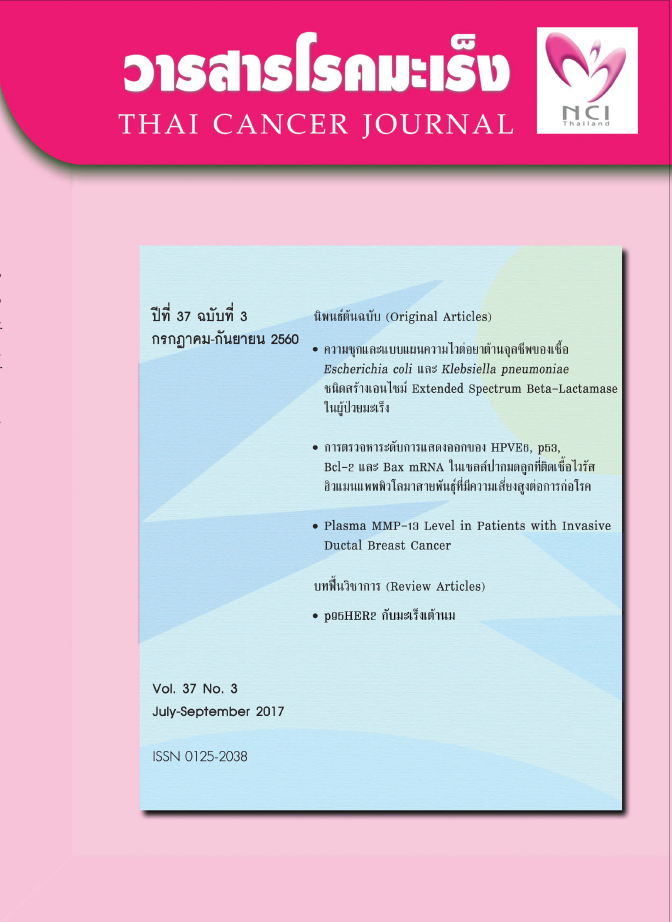Investigation of HPVE6, p53, Bcl-2 and Bax mRNA Expression Levels in Cervical Tissues with High Risk-Human Papillomavirus Infection
Keywords:
p53, Bcl-2, Bax, human papillomavirus, cervical tissuesAbstract
Persistent high-risk human papillomavirus (HR HPV) infection is the major cause of cervical cancer development, in which oncogenic protein; E6 plays an important role by activating tumor suppressor gene p53. Some studies have suggested that E6 oncoprotein may affect some of the genes/ protein in the apoptotic pathway. This study aimed to detect the HPV genotype and investigate the mRNA expression of the gene-related apoptotic pathway p53, Bcl-2 and Bax, as well as the expression of HPVE6 mRNA in cervical samples with HR HPV infection compared with HPV-negative cervical samples. A total of 50 liquid-based cervical samples with diagnostically confirmed cytology were collected between June 2016 and May 2017. HPV DNA detection and genotyping were performed by polymerase chain reaction-enzyme immunoassay (PCR-EIA). Of 50 cervical samples, 15 were randomly selected for study, of which 14 samples were cytologically diagnosed negative for intraepithelial lesion/malignancy (NILM) or low-grade squamous intraepithelial lesion (LSIL); the other was a high-grade squamous intraepithelial lesion (HSIL). The samples were divided into 5 groups according to HPV findings:- no HPV infection, HPV 16, HPV 18, the other HR HPV and multiple infections between HPV16/18 and the other HR-HPV groups, with three samples per group. Two-step reverse transcriptase polymerase chain reaction (RT-PCR) was used to investigate p53, Bcl-2, Bax and HPVE6 mRNA expression levels. Our results showed that HPV52 was the most frequent type, followed by HPV 16, 18, respectively. p53, Bcl-2 and Bax mRNA expression levels in cervical samples with HPV infection showed slightly higher expression than without HPV infection. HPVE6 mRNA expression in the HPV16 infection group was highest compared with the other groups. In conclusion, HR HPV may possibly affect the process in the apoptotic pathway, although the expression of these genes in this study was still unclear. These data could be used for further molecular-level studies of cervical carcinogenesis.
References
HPV Information Center. Human Papillomavirus and Related Disease Report. Available at: www.hpvcentre.net. Accessed on October 30, 2014.
zur Hausen H. Papillomavirus and cancer, From basic studies to clinical application. Nat Rev Cancer 2002;2:342-50.
Gillison ML, Shah KV. Chapter 9; Role of Mucosual Human Papillomavirus in Nongenital Cancer. J Natl Cancer Inst Monogr 2003;31:57-65.
International Agency for Research on Cancer Monograph on Evaluation of Carcinogen Risks to Humans; Human papillomavirus 1995;64:35-222.
Munoz N, Bosch F, de Sanjose S, Herrero R, Castellsague X, Shah K, et al. Epidemiologic classification of human papillomavirus types associated cancer. N Engl J Md 2003;348:518-27.
Walboomers M, Jacob MM, Manos MM, Bosch FX, Kummer JA, Shah KV, et al. Human papillomavirus is a necessary cause of invasive cervical cancer worldwide. J Pathol 1999;189:12-9.
Ramet J, van Esso D, Meszner Z. Position paper -HPV and the primary prevention of cancer: improving vaccine uptake by paediatricians. Eur J Pediatr 2011;170:309-21.
Kim SH, Oh JM, No JH, Bang YJ, Juhnn YS, Song YS. Involvement of NF- B and AP-1 in COX-2 upregulation by human papilllomavirus 16 E5 oncoprotein. Carcinogenesis 2009;30:753-7.
Moody CA, Laimins LA. Human papillomavirus oncoproteins athhways to transformation. Nat Rev Cancer 2010;10:550-60.
Kim MK, Kim HS, Kim SH, Oh JM, Han JY, Lim JM, et al. Review article; Human papillomavirus type 16 E5 oncoprotein as a new target for cervical cancer treatment. Biochem Pharmacol 2010;80:1930-5.
Malaguarnera L. Implication of apoptosis regulators in tumorigenesis. Cancer and Metastasis Rev 2004; 33:367-87.
Zhivotovsky B, Kroemer G. Apoptosis and genomic instability. Nat ReV 2004;5:752-62.
Liao S, Deng D, Hu X, Wang W, Li L, Li W, et al. HPV16/18 E5, a promising candidate for cervical cancer vaccines, affects SCPs, cell proliferation and cell cycle, and forms a potential network with E6 and E7. Int J Mol Med 2013;31:120-8.
Ayatollahi H, Sharifi N, Sadeghian MH, Alenabi A, Ghasemian-Moghadam HR. Immunohistochemical Expression of Apoptosis Regulators in Squamous Cell Carcinoma of the Cervix and Their Associaion with Human Papillomavirus 16/18 Subtypes. Balkan Med J 2014;31:202-7.
Grace VM, Shalini JV, Lekha TT, Devaraj S, Devaraj H. Co-overwxpression of p53 and bcl-2 proteins in HPV-induced squamous cell carcinoma of the uterine cervix. Gynecol Oncol 2003;91:51-8.
Klapsinou E, Argyri E, Panotopoulou E, Daskalopoulou D, Patsouris E, Nonni A, et al. Bax and Bak expression in cervical smears of women with lowand high-risk HPV types: a study of 120 cases. J Cytol 2015;32:223-9.
Jacob MV, van den Brule AJ, Snijder PJ, Helmerhorst TJ, Meijer CJ, Walboomer JM. A non-radioactive PCR enzyme-immunoassay enables a rapid identification of HPV-16 and 18 in cervical scrapes after GP5+/6+PCR. J Med Virol 1996;49:223-9.
Oh JM, Kim SH, Cho EA, Song YS, Kim WH, Juhnn YS. Human papillomavirus type 16E5 protein inhibits hydrogen peroxide-induced apoptosis by stimulating ubiquitin-proteasome-mediated degradation of Bax in human cervical cells. Carcinogenesis 2010;31: 402-10.
Kantathavon N, Mahidol C, Sritana N, Sricharunrat T, Phoolcharoen N, Auewarakul C, et al. Genotypic distribution of human papillomavirus (HPV) and cervical cytology finding in 5,906 Thai women undergoing cervical cancer screening programs. Infect Agent Cancer 2015;10:7.
Marks MA, Gupta S, Liaw KL, Tadesse A, Kim E, Phongnarisorn C, et a. Prevalence and correlated of HPV among women attending family-planing clinics in Thailand. BMC Infect Dis 2015;15:159.
Bharti A, Shukla S, Mahata S, Hedau S, Das BC. Human papillomavirus and control of cervical cancer in India. Expert Rev Obstet 2010;5:329-46.
Woodman CB, Collins SI, Young LS. The natural history of cervical HPV infection: unresolved issues. Nat Rev Cancer 2007;7:11-22.
Downloads
Published
Issue
Section
License
บทความทีตีพิมพ์ในวารสารโรคมะเร็งนี้ถือว่าเป็นลิขสิทธิ์ของมูลนิธิสถาบันมะเร็งแห่งชาติ และผลงานวิชาการหรือวิจัยของคณะผู้เขียน ไม่ใช่ความคิดเห็นของบรรณาธิการหรือผู้จัดทํา







